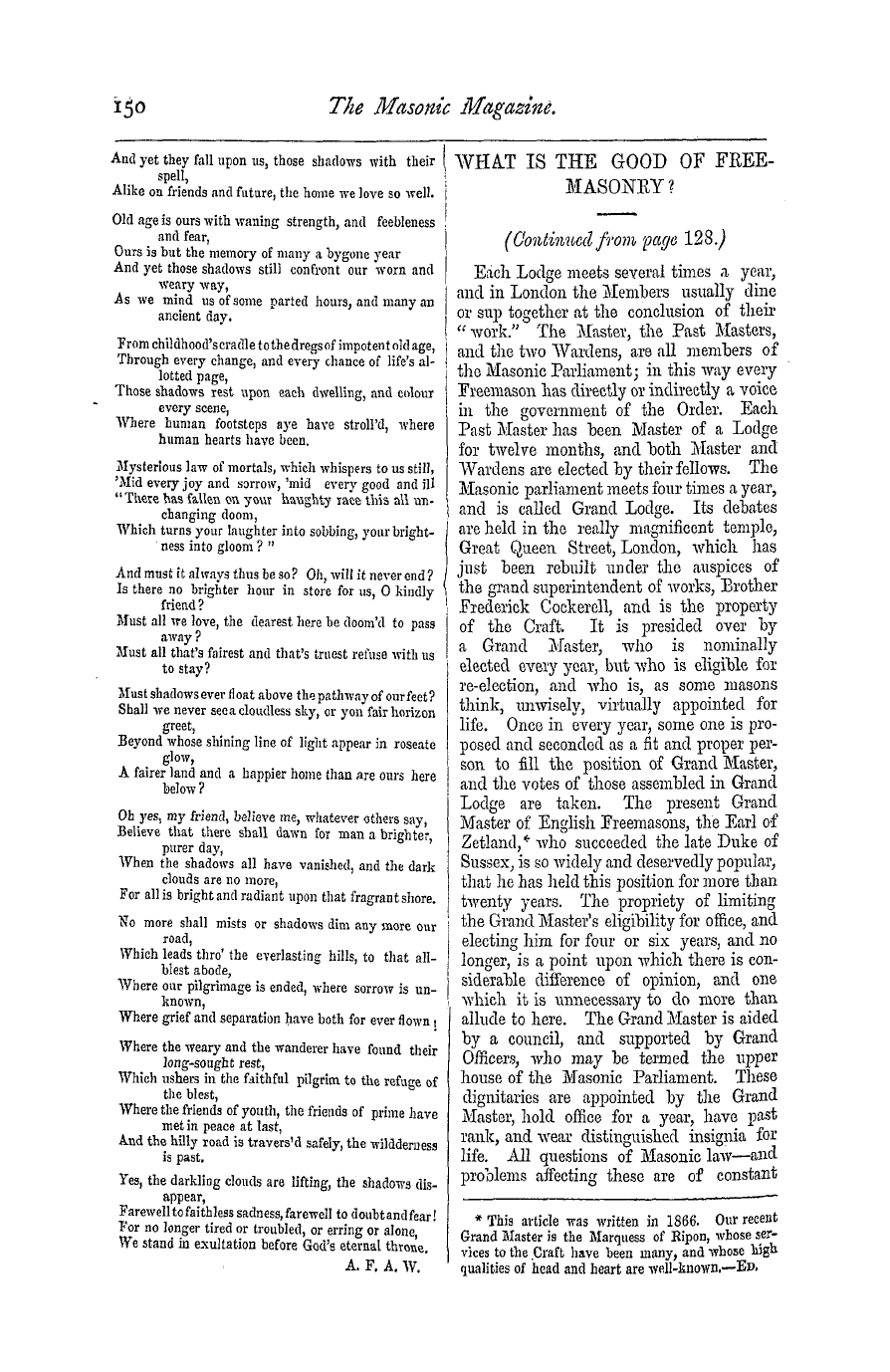-
Articles/Ads
Article Our Archaeological Corner. Page 1 of 1
Note: This text has been automatically extracted via Optical Character Recognition (OCR) software.
Our Archaeological Corner.
Our Archaeological Corner .
A correspondent of tho Edinburgh Scotsman , says : " Within the past ICAV clays I have been informed of a remarkable spectacle that was Avitnessod on midsummer ' s morning at Stonehenge . I am not aware that in any
work on these megalithic circles is reference made , hoivever remotely , to Avhat I am IIOAV about to mention . On the morning in question a party of Americans , Avho had left London for the purpose , visited Stonehenge for the purpose of witnessing the
effects of the sunrise on this particular morning . They Avere not a little surprised to find that , instead of having the field all to themselves , as they had expected , a number of people from all parts of the countryside , principally belonging to the
poorer classes , Avere already assembled on the spot . Inquiries failed to elicit any intelligible reason for this extraordinary early turnout of the population , except this : that a tradition Avhich had trickled
down through any number of generations told them that at Stonehenge something unusual Avas to be seen at sunrise on the morning of the Summer solstice . This piece of rustic information put my informant , ivho is of an antiquarian turn of mind , on the qui vive .
" Stonehenge may roughly be described as composing seven-eightlis of a circle , from the open ends of which there runs eastward an avenue having huge upright stones on either side . At some distance beyond this avenuebut in a direct line Avith its centre
, , stands one solitary stone in a sloping position , in front of Avhich , but at a considerable distance , is an eminence or lull . The point of observation chosen by the excursion party Avas the stone table or altar near the head of ancl Avithin the circle
directly looking down the avenue . The morning was unfavourable , but fortunately just as the sun Avas beginning to appear over the top of the hill , the mists disappeared , ancl then for a feAV moments the onlookers stood amazed at the henomenon
p presented to VIOAV . While it lasted , the sun , like an immense ball , appeared actually to rest on the isolated stone of Avhich mention lias been made , or to quote the quaint though prosaic description of one
present , ' it is like a huge pudding placed on the top of the stone . ' Another very important fact mentioned by an elderly gentleman AVIIO hacl resided for many years in the neig hbourhood , was that on the seting sun at the Winter solstice a similar
p henomenon was observable in the direction of certain other stones to the Avestward . Here , then , is the very remarkable fact that the axis of the avenue of Stonehenge accurately coincides Avith the sun ' s rising at the Summer solsticeand that another
, line laid CIOAVII in the arrangement of the stones coincides with the setting sun at the Whiter solstice . Unless it is conceivable that this nice orientation is the result of chance—which AVOUM be hard to believethe inference is justifiable that the builders
of Stonehenge and other rude stone monuments of a like description hacl a special design or object in vieiv in erecting these cromlechs or circles , or whatever the name antiquarians may give them , and that they are really the manifestations oftheBaalistic or sun-Avorship professed by the early inhabitants of Great Britain , a species of idolatry at one time also universal in
Ireland , and to Avhich the round toivers of that country amply testify . This , of course , is returning to the opinion originally entertained as to the use and purposes of these early ancl Avidely-scattered monuments , and is at total A ariance Avith the opinion of so great an authority as Mr . James Ferguson ,
AVIIO , in his Avork entitled 'Eude Stone Monuments hi All Countries ancl Ages , ' disposes alike of the geologic-antiquarian theory Avhich considers these stone monuments as an evidence of the progressive clevekq . ment of man from primeval
savagedom , as Avell as that Avhich ascribed their origin to the Druids , Avhose temples they Avere supposed to be . If , according to Mr . Ferguson , they Avere the hastily-erected trophies of victories , ancl set up by the people who lived in the very darkest epoch
of our history—viz .: from 400 A . D . to 900 A . D . —not the least extraordinary characteristic , then , _ Avhich Stonehenge possesses is the marvelous precision of its orientation . One cannot help Avondering IIOAVunder such circumstancesthis AVOUM
, , have happened . " Nasi York Dispatch , Young ladies are so economicalthey never throAV aAyay a good match ?
Note: This text has been automatically extracted via Optical Character Recognition (OCR) software.
Our Archaeological Corner.
Our Archaeological Corner .
A correspondent of tho Edinburgh Scotsman , says : " Within the past ICAV clays I have been informed of a remarkable spectacle that was Avitnessod on midsummer ' s morning at Stonehenge . I am not aware that in any
work on these megalithic circles is reference made , hoivever remotely , to Avhat I am IIOAV about to mention . On the morning in question a party of Americans , Avho had left London for the purpose , visited Stonehenge for the purpose of witnessing the
effects of the sunrise on this particular morning . They Avere not a little surprised to find that , instead of having the field all to themselves , as they had expected , a number of people from all parts of the countryside , principally belonging to the
poorer classes , Avere already assembled on the spot . Inquiries failed to elicit any intelligible reason for this extraordinary early turnout of the population , except this : that a tradition Avhich had trickled
down through any number of generations told them that at Stonehenge something unusual Avas to be seen at sunrise on the morning of the Summer solstice . This piece of rustic information put my informant , ivho is of an antiquarian turn of mind , on the qui vive .
" Stonehenge may roughly be described as composing seven-eightlis of a circle , from the open ends of which there runs eastward an avenue having huge upright stones on either side . At some distance beyond this avenuebut in a direct line Avith its centre
, , stands one solitary stone in a sloping position , in front of Avhich , but at a considerable distance , is an eminence or lull . The point of observation chosen by the excursion party Avas the stone table or altar near the head of ancl Avithin the circle
directly looking down the avenue . The morning was unfavourable , but fortunately just as the sun Avas beginning to appear over the top of the hill , the mists disappeared , ancl then for a feAV moments the onlookers stood amazed at the henomenon
p presented to VIOAV . While it lasted , the sun , like an immense ball , appeared actually to rest on the isolated stone of Avhich mention lias been made , or to quote the quaint though prosaic description of one
present , ' it is like a huge pudding placed on the top of the stone . ' Another very important fact mentioned by an elderly gentleman AVIIO hacl resided for many years in the neig hbourhood , was that on the seting sun at the Winter solstice a similar
p henomenon was observable in the direction of certain other stones to the Avestward . Here , then , is the very remarkable fact that the axis of the avenue of Stonehenge accurately coincides Avith the sun ' s rising at the Summer solsticeand that another
, line laid CIOAVII in the arrangement of the stones coincides with the setting sun at the Whiter solstice . Unless it is conceivable that this nice orientation is the result of chance—which AVOUM be hard to believethe inference is justifiable that the builders
of Stonehenge and other rude stone monuments of a like description hacl a special design or object in vieiv in erecting these cromlechs or circles , or whatever the name antiquarians may give them , and that they are really the manifestations oftheBaalistic or sun-Avorship professed by the early inhabitants of Great Britain , a species of idolatry at one time also universal in
Ireland , and to Avhich the round toivers of that country amply testify . This , of course , is returning to the opinion originally entertained as to the use and purposes of these early ancl Avidely-scattered monuments , and is at total A ariance Avith the opinion of so great an authority as Mr . James Ferguson ,
AVIIO , in his Avork entitled 'Eude Stone Monuments hi All Countries ancl Ages , ' disposes alike of the geologic-antiquarian theory Avhich considers these stone monuments as an evidence of the progressive clevekq . ment of man from primeval
savagedom , as Avell as that Avhich ascribed their origin to the Druids , Avhose temples they Avere supposed to be . If , according to Mr . Ferguson , they Avere the hastily-erected trophies of victories , ancl set up by the people who lived in the very darkest epoch
of our history—viz .: from 400 A . D . to 900 A . D . —not the least extraordinary characteristic , then , _ Avhich Stonehenge possesses is the marvelous precision of its orientation . One cannot help Avondering IIOAVunder such circumstancesthis AVOUM
, , have happened . " Nasi York Dispatch , Young ladies are so economicalthey never throAV aAyay a good match ?































